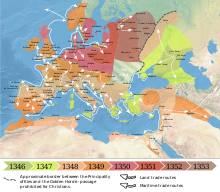The Black Death (Peste negra) was present in Spain between 1348-1350.[1][2] In the 14th-century, present-day Spain was composed of the crowns of Aragon and Castile, the Kingdom of Navarre, and the Emirate of Granada. In the countries on the Iberian Peninsula, the Black Death is well-documented and researched in Navarre and particularly in Aragon (recorded in the chronicle of Peter IV), but less documented in Castile, Portugal and Granada.

In the Iberian Peninsula, the Black Death is estimated to have killed 60-65% of the population, reducing its total population from 6 million to 2-2.5 million. In absolute terms, Europe's 80 million inhabitants were reduced to only 30 million between 1347-1353.[3]
Aragon
editThe Black Death in Aragon is described by contemporary witnesses, such as in the chronicle of Peter IV of Aragon, and has been subjected to thorough research which has demonstrated the effect that the plague could have on a society.
The Black Death reached Aragon in the spring of 1348, and lasted a year. [1] It interrupted the civil war which took place at the time, when the King was able to convince the rebels by whom he was captive to release him as they would otherwise endanger his life because of the migration of the plague.[1]
The collapse of the administration and social order lasted for several years and resulted a breakdown of law and order, widespread criminality, repression from the nobility and rebellions during the following century.[1]
Castile
editThe Black Death in Castile is not as well researched or documented as in Aragon and Navarre. In 1350, it caused the death of king Alfonso XI of Castile in the middle of his warfare against Muslim Andalusia.[1]
In 1435, in response to an outbreak of the plague, the village of Madrid shut its gates. King John II of Castile was receiving ambassadors from the King of France at the time, and while the King fled to Illescas in Toledo for his safety, the ambassadors were led to an area outside the Madrid walls; that area is now known as Embajadores.[4]
Navarre
editThe Black Death in Navarre has been subjected to the research of Maurice Berthe, among others. It had a severe effect on the country, as Navarre was already recovering from a severe famine when the Plague arrived. About 50% of the population are estimated to have died.[1]
References
edit- ^ a b c d e f Harrison, Dick (2000). Stora döden: den värsta katastrof som drabbat Europa (in Swedish). Stockholm: Ordfront. ISBN 91-7324-752-9.
- ^ Álvarez-Nogal, Carlos (2020-11-16). "Economic effects of the Black Death: Spain in European perspective | Investigaciones de Historia Económica". Investigaciones de Historia Económica (in European Spanish): 35–48. doi:10.33231/j.ihe.2020.10.001. hdl:10016/36660.
- ^ "La peste negra, la epidemia más mortífera". 17 August 2012.
- ^ Hughes, Felicity (2020-04-25). "A History of Epidemics in Madrid". The Making of Madrid.
You can help expand this article with text translated from the corresponding article in Swedish. (May 2020) Click [show] for important translation instructions.
|